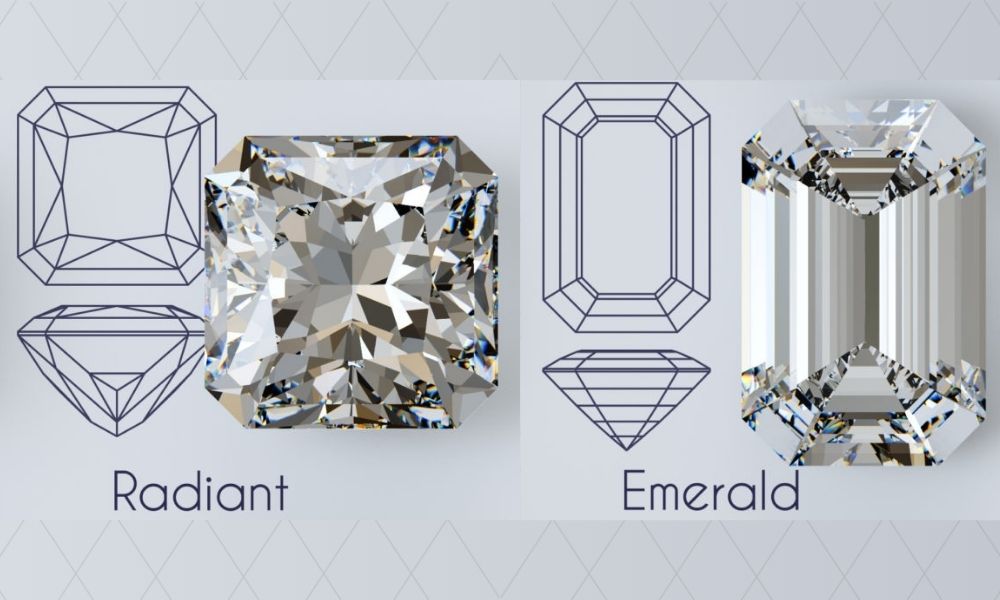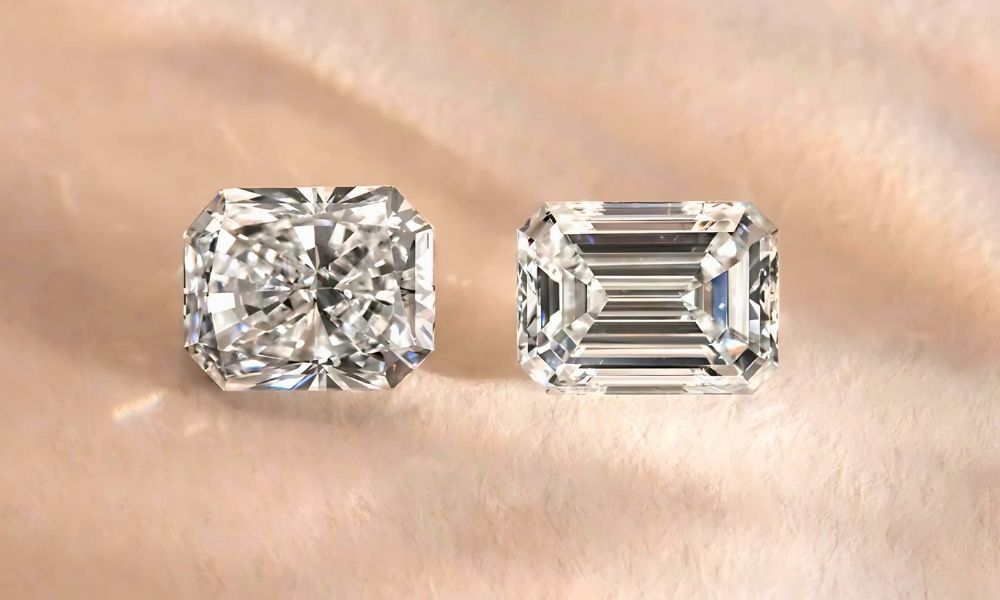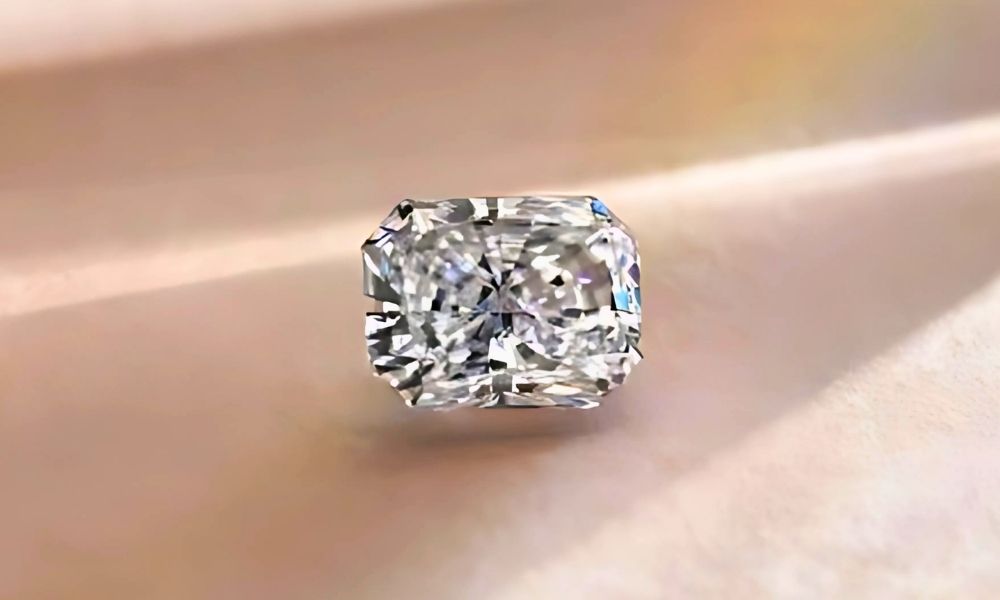When it comes to choosing the perfect diamond shape, two popular options stand out: the radiant cut and the emerald cut. Both shapes are brilliant in their own right and have garnered popularity among those who appreciate the timeless look of fine jewellery. The radiant cut, known for its exceptional sparkle and modern elegance, contrasts beautifully with the emerald cut’s sophisticated and classic appeal.
In the subsequent piece, let’s delve deeper into what each cut signifies, the advantages of the radiant vs emerald cut, and the essential factors to consider when selecting one for your collection. By examining the radiant vs emerald cut in detail, this exploration will help you make an informed decision that aligns with your style and preferences.
Table of Contents
Overview of Diamond Cuts

It is important, however, to understand more about different diamond cuts before comparing the radiant vs emerald cut more specifically. This feature highlights how the cut of a diamond influences its overall beauty and brilliance. Ideal proportions allow for efficient light handling, resulting in extraordinary brilliance and fire. Various cuts can possess different facets and shapes, which ultimately contribute to the variation we see.
Radiant Cut: An Overview

Characteristics
The radiant cut which was designed in the late 1970s by Henry Grossbard takes the appearance of the emerald cut but has the fire of a round cut. Here are some key features:
Shape: Usually smooth and simple with straight edges, although rectangular or square with cut-off corners.
Facets: Primarily comes in 70 facets providing an excellent light return as well as brightness.
Appearance: A radiant cut gives a strong play of light and color and has a contemporary style.
Advantages
Brilliance: The cut has many features, which provide it with light return, making the radiant cut one of the brightest fancy shapes.
Versatility: For instance, it is worn best in solitaire and halo-style settings due to its shared form.
Color and Clarity: The cut can hide inclusions and color to a degree making it ideal for stones that have minor defects.
Considerations
Shape Preference: The radiant cut could be more for the modern flashy type of people.
Cut Quality: As with any diamond, the cut remains the most important factor to consider in any given diamond. A round brilliant cut will be more brilliant than a round brilliant cut poorly cut.
Emerald Cut: An Overview

The emerald cut is a step-cut design that was first developed in the 1500s. Originally designed for emeralds, this cutting technique is now successfully used for diamonds as well. When comparing the radiant vs emerald cut, the emerald cut is defined by its long, elegant lines and rectangular shape. This method, initially exclusive to emeralds, showcases the clarity and color of the diamond beautifully. Here’s what defines an emerald cut:
Characteristics
Shape: Quadrilateral with aligned straight parallel planes making it look classy.
Facets: Usually has 58 subcategories, though some versions may have less Some classifications differentiate it based on clarity and color rather than fire.
Appearance: The emerald cut has a doubling effect owing to the mirrors and highlights the clarity and color of the diamond.
Advantages
Timeless Elegance: The emerald cut gives the piece a traditional look that will please those wanting a vintage/art deco piece.
Clarity Showcase: This cut is outstanding for stones with high clarity, and the cut showcased in this cutting illustrates this perfectly.
Unique Presence: The elongated processes and unmasked faces result in a unique elegant style that projects the hair brand.
Considerations
Brilliance: The emerald cut is generally less cut than the radiant cut, which will not suit some individuals who prefer a brighter diamond.
Color Sensitivity: Due to this approach emphasizing color and clarity, it may not work well with the low quality of the stone.
Radiant vs Emerald Cut: Key Differences

Let’s discuss the key difference between radiant vs emerald cuts:
1. Brilliance and Sparkle
Radiant Cut: This cut allows for maximum brilliance due to the high density of small faces, which give the most spectacular play of light.
Emerald Cut: Lacks the sparkle that one would expect but has a certain retro look that draws attention to how clear everything is.
2. Shape and Aesthetics
Radiant Cut: They are more flexible in shape and can be angular, square, or rectangular which gives them a touch of modernity.
Emerald Cut: Resembling the typical historical house, even when of contemporary design, always rectangular and with an air of dignified simplicity.
3. Clarity and Color Perception
Radiant Cut: Will hide inclusions, ideal for the stones that have minor inclusion of non-desirables or slight color differences.
Emerald Cut: Needs higher clarity and color quality to impress, perfect for flawless or almost flawless gemstones.
4. Setting Compatibility
Radiant Cut: Complements a wide range of settings and may be combined with halos as well as with delicate motifs.
Emerald Cut: Most of the time, it is shown in less complex or rather more traditional environments to boost its sophistication.
Tips for Quality: Radiant vs Emerald Cut

A few cut styles are more or less tolerant in one or more of the four Cs, and the radiant vs emerald cuts are quite different in how they reveal their imperfections. With the emerald cut, you’ll need to consider greater clarity because the large table increases the visibility of flaws and blemishes. Since there is less focus on color with this cut, you can opt for a lower color grade to achieve higher clarity.
In contrast, radiant cut diamonds’ faceting style is less sensitive to internal flaws, as they can hide inclusions under brilliant light. You could find a very pretty SI1 or SI2 clarity radiant cut diamond or choose a better color, as this cut tends to display more color. With either cut, you could compromise slightly on the color tone if your ring is made from yellow or rose gold rather than white gold or platinum.
Choosing The Best Radiant Cut

When picking the best radiant cut, decisions will involve sparkle type and reflections, especially when comparing radiant vs emerald cut diamonds. Firstly, there are faceting options between traditional and what is also called “crushed ice” faceting. Conventional faceting produces a smaller number of large flashes of light, while crushed ice faceting creates a larger number of small flashes.
Once you have your preferred style of shimmering, the next consideration is achieving equal levels of contrast and brilliance. Contrast refers to the dark patches of reflection within a stone, while brilliance is defined as areas of light reflection. Ensure that both elements are even and well-spaced; inadequate contrast or inconsistent levels can result in an appearance where the positive and negative are indistinguishable, yielding little visible contrast illuminated by light.
Choosing The Best Emerald Cut

Picking the right emerald-cut diamond is all about searching for a dark, straight hall mirror effect. When comparing radiant vs emerald cut diamonds, it’s essential to note that if the vertical facets of the emerald cut vary between dark and light, a “hall of mirrors” effect occurs. To look for this effect, walk along each of the layers in “steps” out from the center of your stone. Ensure that the steps are straight and symmetrical, meaning they should be mirror images of each other. Additionally, make sure the changes occur in an order of light followed by dark and vice versa. If so, then you have an excellent hall of mirrors, which will give that notable emerald cut shine.
Conclusion
It is important to decide whether the diamond should be sized in a radiant cut or an emerald cut, as this choice depends on your preferences for the occasion, style, and the aspects you value in the stone. If you consider brilliance and a modern look important, the radiant cut may be the best option for you. However, if you lean towards simplicity and a more understated style, the emerald cut could be just what you’re looking for. Regardless of which cut you choose, the radiant vs emerald cut both offer breathtaking elegance and sophistication, ensuring that your diamond will be cherished for decades.
FAQs about Radiant vs Emerald Cut
Q1. Is emerald cut or radiant cut better?
In choosing radiant vs emerald cut, if the diamond is for personal preference, and if the earrings need to have a shabby chic look or have strict clarity, emerald cut may be a better option. Among them, the radiant cut might be appropriate for someone who wants a diamond modern modern-looking and bright. Overall, it is always about which style you find more appealing!
Q2. Is radiant cut more expensive?
No, they actually are more affordable than most other diamond cuts! This is because the rectangular shape of the radiant cut utilizes more of the diamond’s roughness compared to other shapes like rounds, ovals, and cushions. In comparison to the radiant vs emerald cut, the radiant cut allows for a near-colorless stone with maximum clarity, which is often not feasible with other rectangular-shaped gems like the emerald cut.
Q3. What is the disadvantage of an emerald cut?
It is somewhat less bright than brilliant cuts and has a better form of cut known as the shape. Nonetheless, suppose the fire of your diamond is of particular significance to you. In that case, an emerald-cut engagement ring is one that you might be well advised to avoid in favor of a round, princess, or radiant cut. When comparing radiant vs emerald cut diamonds, the radiant cut typically offers more brilliance and sparkle, making it a better choice for those who prioritize a vibrant display of light.
Q4. Why choose a radiant-cut diamond?
Here are a few points if you are confused about which one to choose, radiant vs emerald cut:
Selecting a radiant-cut diamond provides an equal amount of brilliance and distinguished essence. This cut features a rectangular shape with rounded corners, allowing the diamond to reflect light to the observer to the maximum extent. Its light performance is further enhanced by a combination of brilliant and step facets, while the trimmed corners give it a unique appearance. When comparing radiant vs emerald cut diamonds, radiant cuts typically appear larger than their actual carat weight, making them visually appealing. In conclusion, they are ideal for those who desire a wonderful, eye-catching stone with character.
Q5. What diamond cut is the prettiest?
Indeed, the brilliant round cut is the best of all, or the least way recommended for a diamond to be cut.
Stay Tuned to Gems Tycoon for all gems-related articles.









